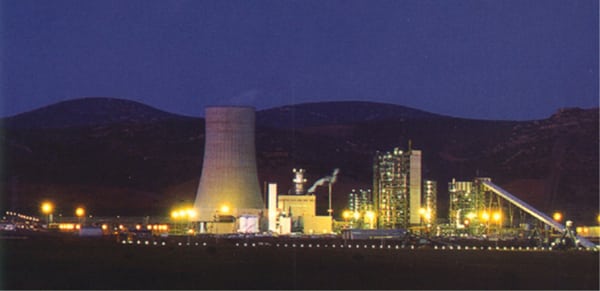Spain Makes Headway in CCS Efforts
A 14-MW pilot plant built by energy firm ELCOGAS at its 335-MW integrated gasification combined-cycle (IGCC) facility at Puertollano in Spain in September captured its first metric ton of carbon dioxide. Now the company plans to begin tests to procure more technical and economic information about carbon capture and storage (CCS), including how efficient it is to co-produce hydrogen and power with carbon capture processes.
The pilot plant, built with support of the Spanish Science and Innovation Ministry and the regional government of Castilla La Mancha, is the first industrial-scale pilot plant in service in Spain and the first worldwide to integrate CCS into a power-producing IGCC plant, ELCOGAS says.
The Puertollano IGCC plant some 200 km south of Madrid, which began commercial operation in 1996 with natural gas and in 1998 with syngas from gasification of an equal mixture of local coal (with an ash content of more than 40%) and high-sulfur petcoke, is also generally regarded as one of the largest IGCC facilities in the world (Figure 2). According to ELCOGAS, commercial application of gasification technology over more than a decade has resulted in “excellent environmental performance.” The company claims that the emissions of air pollutants was “much lower than any other technology based on coal, coke, or biomass, and very close to or better than those from [natural gas combined-cycle technology].”
 |
| 2. Building castles in Spain. Spanish energy firm ELCOGAS captured its first metric ton of carbon dioxide at a 14-MW pilot plant built at its 335-MW integrated gasification combined-cycle (IGCC) facility at Puertollano this September. The IGCC plant, which has been gasifying local coal and petcoke since 1998, is generally regarded as one of the world’s largest IGCC facilities. Courtesy: ELCOGAS. |
The ELCOGAS pilot project highlights Spain’s dogged efforts to make headway in CCS technology. Also under way in the country known more for its policies to spur growth of the renewable power sector is an oxycombustion plant being developed by a government institution, Fundación Ciudad de la Energía (CIUDEN), and Spanish utility Endesa. The Integrated Carbon Capture and Sequestration Technology Development Plant under construction at Endesa’s Compostilla power plant in Ponferrada will use a 30-MWth Foster Wheeler–built circulating fluidized bed unit to test that company’s Flexi-Burn carbon capture technology. The unit, which will test burn a wide range of domestic (mostly anthracite) and imported coals—as well as biomass—is expected to start operations by the second half of 2011. Testing programs are expected to follow thereafter.
The Compostilla project is one of six CCS projects granted a total of €1 billion in economic recovery funding from the European Union (EU) last year. In mid-October, the 27-nation alliance’s Zero Emissions Platform (ZEP) released an updated Strategic Deployment Document urging member governments to establish regulatory frameworks and provide funding as soon as next year if CCS demonstration projects are to be operational by 2015, as anticipated. The group said that getting CCS beyond the demonstration stage was critical, citing a recent European Commission analysis that suggested no CCS projects would be built beyond the demonstration phase if carbon prices were relatively low after the EU met renewable energy and emission targets as planned in 2020.
ZEP noted, however, that significant CCS progress has been made around the world since 2006: 18 pilot projects have already started, and several large-scale (more than 100 MW) demonstration projects are in the pipeline. Citing the Global CCS Institute, the group said that as of April 2010, 238 projects involving carbon capture, transport, and/or storage were either active or planned worldwide. Of these, 80 sought to demonstrate the entire CCS chain and had goals to capture more than 1 million metric tons of carbon dioxide for coal or 500,000 metric tons of carbon dioxide for gas (nine mainly storage-oriented projects are already operational, two are under construction, and 69 are in the planning stages). Of the 80 projects, moreover, 44 are in the power sector and 25 are in Europe, the group said.
As in the U.S., European CCS projects are prone to delays, and many, confronted by financial challenges, have been shelved. In late October, for example, Finnish partners Fortum and Teollisuuden Voima (TVO) announced they would discontinue plans to build a large-scale CCS demonstration project at the companies’ jointly owned Meri-Pori power plant. The so-called “Finncap” project had been under consideration for €500 million in funding from the EU’s CCS demonstration program. Fortum, a company that focuses primarily on nuclear and hydropower, said that the decision was prompted mostly by “technological and financial risks related to the project.”
Also in October, Norway’s Ministry of Petroleum and Energy delayed a final investment decision to execute a large-scale CCS project whose construction is under way at the Mongstad refinery on the country’s western coast, after “theoretical studies” indicated health and environmental risks related to amine capture technology. The studies were among documents submitted in connection with an application for an emission permit for the project by energy company Statoil. Testing was planned to start in early 2012 at the facility, which would have captured carbon emissions from an existing catalytic cracker at the refinery as well as from a gas-fired combined heat and power plant due to come online this year. The final investment decision has now been delayed to 2014.
In response to the ministry’s decision, Scandinavian research group SINTEF agreed that amine-based carbon capture could result in the emission of nitrosamines, “which may be harmful to health,” it said. However, the group added that, though more data was needed to ensure “one environmental problem [was not substituted] for another,” it was “possible to develop chemical capture technologies without generating negative health effects.”
—Sonal Patel is POWER’s senior writer.